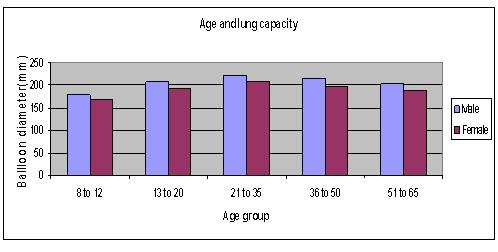| Complexity level: | 6 |
| Project cost ($): | 20 |
| Time required: | Preparation will take approximately one day, and observation and recording of data will require one more day |
| Material availability: | Easily found |
| Safety concerns: | Basic safety requirements |
Hypothesis
A person’s lung capacity will increase until he is in his 20’s, after which his lung capacity will slowly decline as he grows older.
Overview
Lung capacity
Lungs are respiratory organs that remove waste gases such as carbon dioxide from our body while supplying oxygen from the air to our blood vessels, whereas lung capacity refers to the amount of air that our lungs can hold. All of us have two lungs that are located in our left and right chest, and an average person has a lung capacity of approximately 4000 to 6000 cm3.
The capacity of human lungs can be said to be overbuilt when it is compared against our respiratory needs, since we only use about one third of our lung capacity. The lung capacity of a person usually depends on his or her gender, height, weight and age. For example, women have about 25% less lung capacity when compared to men. In addition, people such as those who are tall, non-smokers, live in high altitudes, athletes and musicians playing wind instrument musicians usually have a larger lung capacity.
Tidal volume refers to the volume of air breathed in and out by a person during normal respiration whereas the total lung capacity refers to the maximum amount of air that a person can take in during a maximal inspiration, which occurs when we take a deep breath. Vital capacity on the other hand refers to the maximum volume of air that a person can force out of his or her lungs after taking a maximal inspiration.
Scientific Terms
Materials
The materials required for this science fair project:
- 10 boys and 10 girls aged between 8 to 12 years old
- 10 boys and 10 girls aged between 13 to 20 years old
- 10 men and 10 women aged between 21 to 35 years old
- 10 men and 10 women aged between 36 to 50 years old
- 10 men and 10 women aged between 51 to 65 years old
- 100 balloons
- 2 wooden blocks
- 100 laundry clips
- 1 ruler
Procedure
1. The independent variables in this science fair project are the gender and age group of the participants. The dependent variable is the size of the balloon blown, which is measured using a ruler. The constants (control variables) are the type of balloon used and the number of attempts.
2. Give each student aged between 8 to 12 a balloon. Instruct them to take a deep breath after stretching the balloon for a few times. Use a laundry clip to block each participant’s nose, and instruct them to blow the balloon using the air in their lungs, and hold the end of the balloon tightly after blowing to prevent the air from escaping.
3. Use a ruler and two wooden boxes to measure the diameter of the balloon. Allow each participant three attempts to blow the balloon, and record the size of the largest balloon that they are able to blow. Calculate the average maximum diameter of the balloons blown after all the ten participants in the same age group and gender have completed the task. Record the measurements in the table given below.
4. Repeat procedures 2 and 3 using the male and female participants from the four remaining age groups. Calculate the average maximum diameter of the balloon for each group and record it in the table given below.

Results
Male participants were observed to have a larger lung capacity compared to female participants. In addition, participants from the age group of 21 to 35 years old were observed to possess the largest lung capacity compared to other age groups.
| Gender | Lung capacity determined from the diameter of the inflated balloon (mm) | ||||
| 8 to 12 years old | 13 to 20 years old | 21 to 35 years old | 36 to 50 years old | 51 to 65 years old | |
| Male | 180 | 208 | 224 | 216 | 203 |
| Female | 168 | 193 | 209 | 198 | 189 |
Use the graph below to plot the experimental data recorded in the table above.

Conclusion
The experimental data and analyzed results support the hypothesis that a person’s lung capacity will increase until he is in his 20’s, after which his lung capacity will slowly decline as he grows older.
Our lung capacity is an indicator of our health condition. As lungs supply oxygen to the blood vessels in our bodies and remove any carbon dioxide generated as waste gases from our blood stream, it is very important for us to keep our lungs healthy. Habits such as smoking not only reduce our lung capacity but will also damage our lungs, leading to lung cancer.
Also consider
This science fair project can be repeated to compare the lung capacity of smokers and non-smokers.
Try to repeat the experiment to compare the lung capacity of athletes and non-athletes.
References
Human lung - http://en.wikipedia.org/wiki/Human_lung
What should I know about lung capacity - http://www.wisegeek.com/what-should-i-know-about-lung-capacity.htm
Lung volumes - http://en.wikipedia.org/wiki/Lung_volumes

